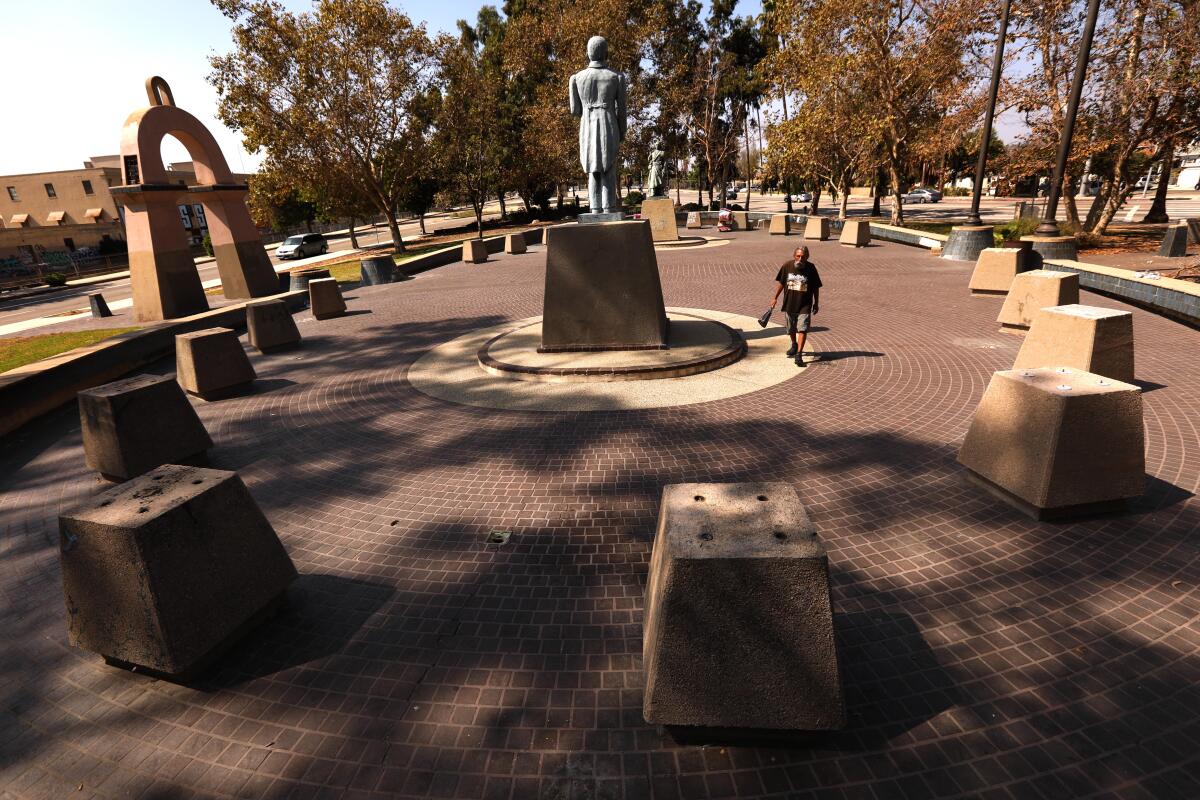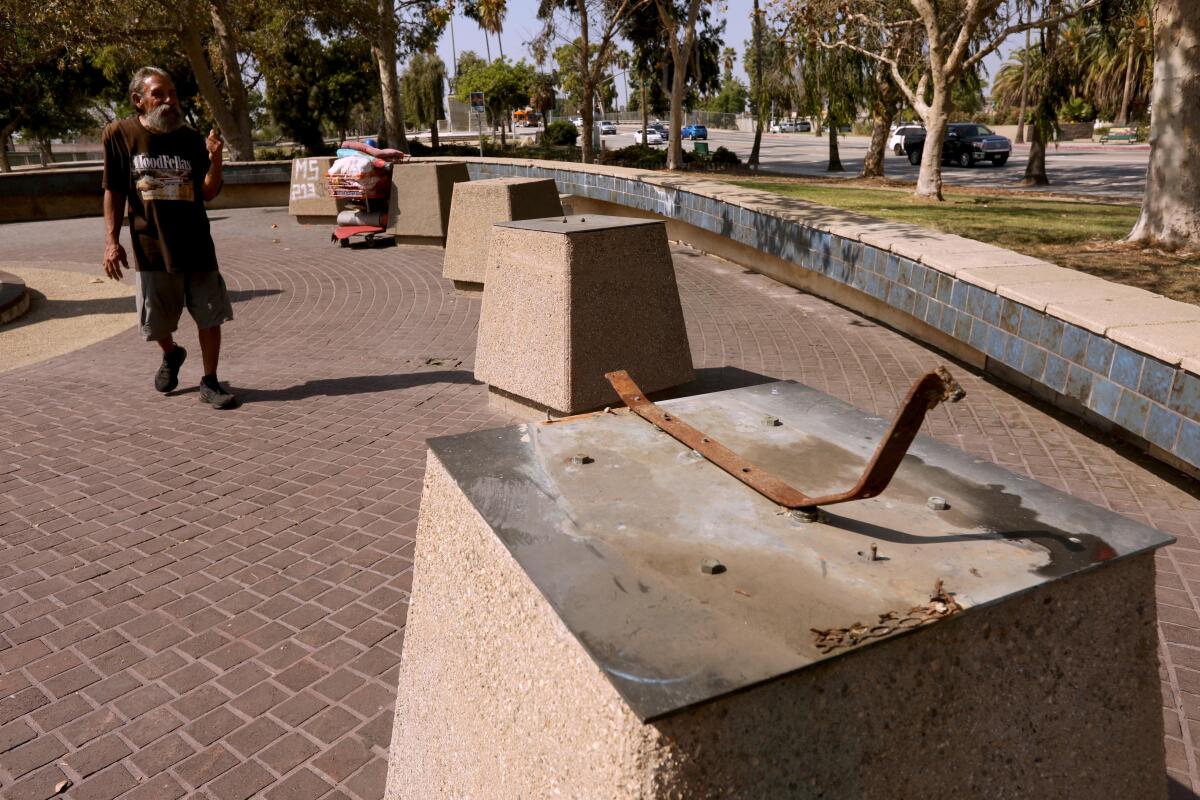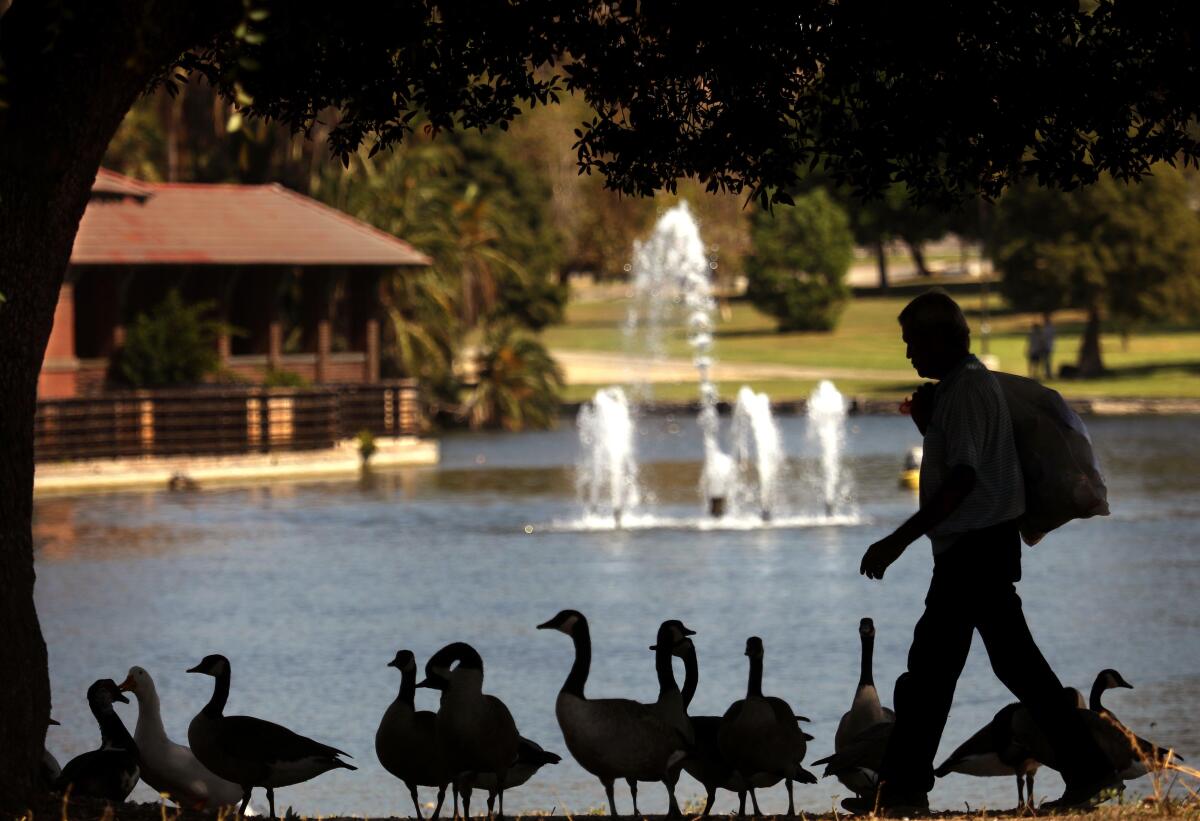Column: Who’s stealing the statues of Pancho Villa and other Mexican heroes from an L.A. park?

Pancho Villa was the first Mexican legend to disappear — stolen in the dead of night, found by Los Angeles police officers in someone’s backyard, then pilfered once more and never seen again.
Other heroes slowly vanished. Gen. Ignacio Zaragoza, who won the Battle of Puebla that Cinco de Mayo commemorates. Ramón Lopez Velarde, the poet from Jerez, Zacatecas, regarded as Mexico’s best bard. Lázaro Cárdenas, the Mexican president who nationalized his country’s oil industry.
They were the bronze busts, statues and plaques of Mexican icons that once populated El Parque de Mexico, a trio of traffic islands in Lincoln Heights at the intersection of Valley Boulevard and Mission Road. There used to be 33 in all, each representing a Mexican state, all adorned with a plaque detailing whom the sculpture honored and the name of the donors who made it happen — the Mexican government, local organizations and individuals.
Today, just a handful remain.
The vanishing statues are like something out of an M. Night Shyamalan movie set in L.A.’s Eastside. First they took the statues. What’s next?!
Determined to find out what was going on, I visited El Parque in late September at the invitation of Sergio Mariscal, head of press and social communications for the Mexican Consulate in Los Angeles. He was on a fact-finding mission after people reached out to his office to voice concern about the missing statues and the park’s condition. Normally gregarious, the Baja California Norte native’s face turned increasingly crestfallen as he saw what was before us.
Gang graffiti defaced the concrete base upon which stood a massive statue of Emiliano Zapata on horseback, donated to L.A. by Mexico City. The same fate befell a similar monument to Jose Maria Morelos, one of the leaders of the Mexican War of Independence. An arch that once held a replica of the bell that founding Father Miguel Hidalgo rang was empty.

“Our community hasn’t taken care of this — it’s a lost opportunity,” he said while taking photos of the damage. “Such a beautiful space.”
Mariscal let the thought trail off as he noticed sun-bleached spots where plaques and lettering once were. “They even robbed this? Híjole.”
Vandals have targeted public monuments since the days of the Sphinx — but El Parque de Mexico seemed immune to vandalism for a long time.
It dates back to 1976, when longtime Eastside Councilmember Art Snyder secured funds for its creation as part of a grade separation project for the railroad tracks that serve as Lincoln Height’s southern border. The location for El Parque was deliberate. Across the street is Lincoln Park, which had hosted Cinco de Mayo celebrations since the 1930s. The first Mexican hero honored with a statue was Benito Juarez, Abraham Lincoln’s Mexican counterpart. His statue looked across Main Street to a 1926 bronze bust of Honest Abe.
Rudolph Valentino lost his nose three times. Florence Nightingale had both arms lopped off.
“When the park was proposed, some of the other councilmen said that it would be destroyed by vandals,” longtime Snyder aide Yolanda Guerra told The Times in a 1985 article about the sad state in general of statues in L.A. “But the amazing thing is we’ve had no vandalism, no graffiti. People here respect it as a tribute to the heritage of this city and the Mexican community.”
Famous last words? Well, no. The non-vandalism winning streak lasted longer.
There were annual wreath-laying ceremonies on Cinco de Mayo at the monuments to Juarez and Zaragoza. Aztec dancers practiced in the plaza throughout the years as most of the busts looked on.
“There was so much pride for mexicanidad back then,” said Frank Villalobos. His firm, Barrio Planners, designed El Parque de Mexico, and went on to plan Mariachi Plaza in Boyle Heights and the Whittier Boulevard arch in East Los Angeles.
He said the final statue was installed in 1996. Villalobos and his associates kept tabs on El Parque, the same way they do for all their projects. The busts weathered normal wear-and-tear, but he said the city showed little interest in upkeep the way they did with the statues across the street in Lincoln Park. Once thieves made off with Pancho Villa’s bust a decade ago, El Parque’s condition rapidly deteriorated.
Villalobos reached out to the Department of Recreation and Parks to see if maybe the statues were removed for safekeeping, but he never got a response. His last complaint was a letter sent last year to the office of then-Councilmember Gil Cedillo, whose district included El Parque.
“It’s devastating to see the care gone to waste,” Villalobos said. “Someone didn’t guard the treasure. It’s very hurtful. It touches the soul that someone is doing this to us. I don’t know who to blame, because no one wants to take any credit or fault.”

The Department of Recreation and Parks did not respond to multiple requests for comment. Neither did Cedillo’s office until mid-November, when his communications director told me El Parque had a new council member in charge: Kevin de León.
If you’ve been following L.A. City Hall news, there are two words for this: Ay caramba.
Lincoln Heights played a cameo in the infamous leaked racist tape scandal that has upended city politics. In it, Cedillo is heard repeatedly asking De León and then-Council President Nury Martinez that they help remove the neighborhood from his district because he felt it had been “taken over by whites.”
His petition was partially successful — Lincoln Heights is now split between De León and Eunisses Hernandez, who beat Cedillo in the June primary. But the redistricting that made Cedillo’s wish come true is now part of an investigation by California Atty. Gen. Rob Bonta that’s examining whether Cedillo, De León and Martinez disenfranchised Black voters in the process.
De León’s chief of staff, Jennifer Barraza, said her boss has commissioned an analysis on El Parque that’s scheduled to be completed in the coming months.
“We won’t even know until we get that [what is] the extent of the damages and what needs to get fixed,” she said. The plan after that is to restore El Parque as part of a larger project around Lincoln Heights, and team up with city departments and reach out to the original donors and artists behind the busts to see how everyone can bring back the park to its past.
“But what’s the saying?” Barraza dryly asked, alluding to the scandal De León continues to find himself in. “You make plans, God laughs.”
His face is showing a few lines. And it’s splotched with a few unsightly age spots.
El Parque was in worse shape than ever when I returned last week.
A wooden welcome sign was smashed in half. A used Old Spice deodorant stick sat at the base of a bronze statue of Cuauhtémoc, the last Aztec emperor. A full-bodied likeness of singer-songwriter Agustín Lara that held a dried white flower was so oxidized it looked like an “Avatar” character. The homeless encampment that Mariscal and I saw back in September was bigger.
People who jogged alongside Valley Boulevard and Mission Road deliberately altered their routes to avoid El Parque. One of them was Angel Martinez, a Lincoln Heights native who cut across the driveway of Cal-Mex classic G.E. Chano’s with his black Labrador retriever, Blue.
“It was a nice-looking place, but some people are taking advantage of it,” said the 56-year-old, waving to the encampment. Someone he knows just moved there two weeks ago after being evicted. “Why would you want to go there?”
Alonso Real waited on a nearby street corner for a ride to his job as a landscaper. He attended festivals at El Parque that he remembered from years ago, but couldn’t recall the last time one happened.
“L.A. is a Mexican city, and people should take pride in [that],” said the native of Puebla. He pointed to El Parque. “What’s happened over there is a disgrace we all let happen.”
More to Read
Sign up for Essential California
The most important California stories and recommendations in your inbox every morning.
You may occasionally receive promotional content from the Los Angeles Times.











